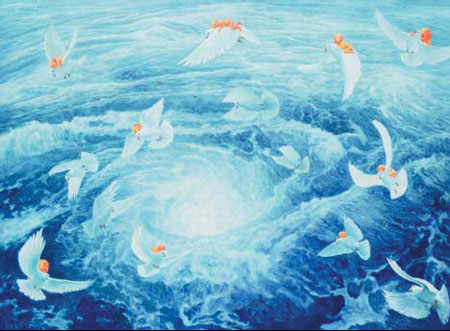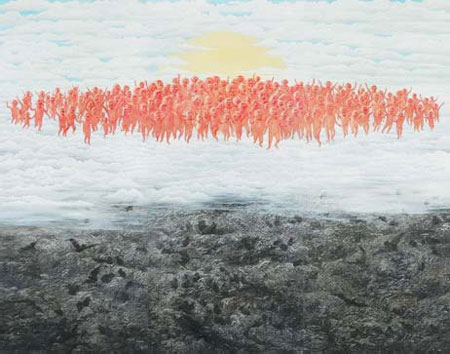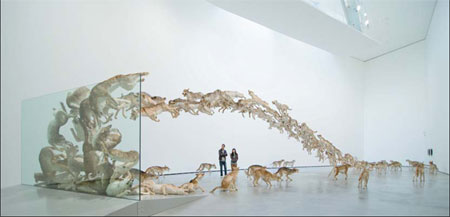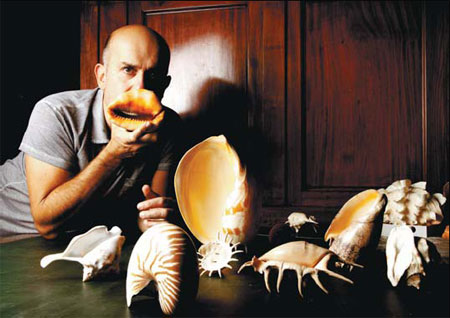Chinese palette
Updated: 2013-06-21 09:02
By Mariella Radaelli (China Daily)
|
|||||||||||
|
Fang Lijun's oil painting Dream of Peace. Photos Provided to China Daily |
|
An untitled work by Fang from 2011. |
|
Cai Guoqiang's work A Wolf Among Wolves. |
|
An artist with his shells at this year's Venice Biennale. |
Europeans have developed taste for diverse array of work by china's artists
Contemporary Chinese art has a strong presence at this year's Venice Biennale, evidence of a growing appetite for it across Europe.
Stimulating exhibitions displaying the work of both new and established artists that is surprising, entertaining and moving represents a diverse national artistic landscape that is winning growing global respect.
An exhibition titled Culture-Mind-Becoming, which opened at the Biennale on June 1, aims to embrace the complexity of thought and themes characteristic of contemporary Chinese art, with its free and unexpected aesthetics. Presented by the Global Art Center Foundation at Palazzo Mora and Palazzo Marcello, it illustrates and interprets the major expressions of an extremely heterogeneous art scene.
The exhibiting artists include renowned names familiar to the US and European art circuits such as Xu Bing and Cai Guoqiang, while the solo show A Cautionary Vision is devoted to Fang Lijun, a prominent representative of the 1990s China New Art, and an exponent of the so-called cynical realism movement.
Fang's art is an emblematic and remarkable example of how a modern-day A-list Chinese artist pushes deeply into pure painting, avoiding the influences of the signal movements of modern art.
Fang took a formative trip to Germany, but his approach is immediate, not mediated by the European avant-garde, from futurism to surrealism, which changed the course of painting so dramatically.
Fang's 15 large paintings are on display at Palazzo Marcello: each 7 to 8 meters wide depicting magnificent scenery, figures of people either floating in clouds or dwelling in the sea, and newborn babies riding storks or enclosed in claustrophobic bubbles. All the well-balanced compositions are characterized by a playful, ironic painterly touch, and a vivid sense of fragments.
According to curator Danilo Eccher, current director of Galleria Civica d'Arte Moderna e Contemporanea in Turin, Fang's art expresses a cautionary vision of the structural intricacies of world reality, so it demands to be analyzed and interpreted in the context of complexity theory, which interconnects with chaos theory, complex algorithms and quantum physics.
"In this context, the work of Fang testifies to the complex relationship between one-off and multiple, singularity and quantity, just as, in the algorithm of starlings in flight, the chaotic unpredictability of one bird's movement triggers an orderly collective of birds that move together in unison," the curator says.
His art is imbued with the Eastern metaphorical visual tradition. "It enshrines all the secrets of the East," Eccher says. "A sweet, simple figurative style enveloped in a brilliant use of color; a visionary, childlike fascination with an unattainable world; and a calm, graceful, balanced narrative. But all of this is just the brilliant patina of a style of painting that is able to suggest the contemporary anguish of loss of identity, the obsession of the collective, the presence of disease, pain, sin. It is an art of ambiguity and deceit, of levity and depth, of nightmares and emotions, of cynical fantasies.
"Solar luminosity and nocturnal tragedy coexist in these works, which liberate bats and mice, cram jubilant crowds of madmen on the edge of the abyss. Fang Lijun does not simply dramatize contradiction; rather than limit himself to the astonishing effect of opposition, his cynical realism is in reality a narrative about complexity, about the art of chaos that refutes linear interpretation, and that is immersed in an engorgement of languages and meanings."
Having innate insights into the popular knowledge of his national heritage, Fang is an epic storyteller whose art derives from a sensitive observance of the vast reality of his native China.
Eccher considers Fang one of the most innovative of today's painters. "His figurative paintings, so purely Chinese, are at virtuoso level both in technique and precision, especially regarding his passion, so typically Chinese, for details."
Fang calls himself a "wild dog": the last thing he needs is conversion to any symbol. He resists all symbols.
Interest in contemporary Chinese art has grown enormously over the past 20 years. But in general, how is contemporary Chinese art perceived in Europe?
The International Art Venice Biennale presented the first artists from the Chinese mainland exactly 20 years ago.
"After the pioneering phase of great enthusiasm and curiosity, which started in the early 90s, about 10 years ago we moved on to a second phase, entirely focused on investigation, a more accurate study and critical analysis," Eccher says. Germany was the first European country to establish stable relationships with Chinese artists, he says. "Nevertheless, some artists preferred to deal with French galleries and art dealers." Eccher insists that Italy today is one of the countries most interested in Chinese art.
"Several collectors and specialized galleries, such as Galleria Continua and Primo Marella, have opened branches in Beijing. In general, many galleries both in Europe and America have expanded their operations into China, an extremely creative part of the world nowadays."
Today's Chinese artists are at a riveting stage, with the majority erudite, according to Eccher. "A-list Chinese artists know Western art history quite well, but are not affected by the very idea of the avant-garde, which has been introduced through contact with the West, since it does not belong to their own spirit and DNA.
"That is why their signature iconography is very much freer; that is why Chinese art is an incredible aesthetic laboratory in which artists can experiment with new interpretative methodologies. I personally spot exceptional talent every time I visit China."
The European viewer interacts with a Chinese painting in a less predictable way than when put in front of a contemporary Western art object, he says.
"Unexpected surprises are disclosed to a Western gaze; she or he can experience a sense of disorientation or alienation in front of a Chinese artwork. Because any aesthetic experience is not a gratuitous epiphany: viewers bring their aesthetic knowledge to the aesthetic encounter with the art object."
This makes this particular "Chinese experience" more challenging, he says.
"We are inviting European viewers to interact with fascinating art codes coming from China."
It is almost obligatory now to mention the presence of Xu Bing and Cai Guo-Quiang, both in the first and second sections of the exhibition. Xu, widely regarded as one of the most important artists of his generation for informing his work with the engagement of language and history, in Venice presents his new multimedia installation Work on Site. Cai, whose artistic language has a direct and deliberate reference to Chinese iconography (his gunpowder works are renowned on a global scale) returns to Venice for the third time.
The first collective section titled Rediscover, which is organized by independent Dutch curator Karlyn De Jong, highlights the fact that many Chinese artists feel obliged to rediscover their own cultural roots as a source of nutrition for their work.
According to De Jong, in Europe there are two different perceptions towards contemporary Chinese art. "One is that of curiosity and interest for what is happening in your country, an attitude that goes beyond personal taste. China and Chinese art is a 'world' that for us Europeans is very difficult to get an insight into. To understand such a varied culture is not easy and requires serious research in many aspects of Chinese life."
The second attitude? "I am afraid it is a negative one: a large number of Europeans are not open enough to learning new things. It is an opinion that considers European, or Western, art as the main or the real art.
"Chinese art is visually quite different, for example, from the European Zero movement. Since it is so richly varied, and understanding it requires a lot of knowledge, it is an easy way out to just say it is 'not good'. For me, art is always an expression of a human act, no matter whether I personally like it or not."
The second section, Ingrandimento (Enlargment), which is curated by Huang Du and Yang Shinyi, aims to show the contemporary Chinese aesthetic in its grandest variety, and reflects on the value of contemporary Chinese art, which lies in refracting cultural potential and vitality in the process of China's modernization.
By contrast a delicacy and gentleness pervades Mao Lizi's abstract artworks, inventive and very poetic in a minimalist manner in his personal quest for infinity.
For China Daily
(China Daily European Weekly 06/21/2013 page24)
Today's Top News
List of approved GM food clarified
ID checks for express deliveries in Guangdong
Govt to expand elderly care
University asks freshmen to sign suicide disclaimer
Tibet gears up for new climbing season
Media asked to promote Sino-Indian ties
Shots fired at Washington Navy Yard
Minimum growth rate set at 7%
Hot Topics
Lunar probe , China growth forecasts, Emission rules get tougher, China seen through 'colored lens', International board,
Editor's Picks

|

|

|

|

|

|









